Late Cenozoic Uguumur and Bod-Uul Volcanic Centers in Northern Mongolia: Mineralogy, Geochemistry, and Magma Sources
Abstract
1. Introduction
2. Geological Background. Uguumur and Bod-Uul Volcanic Centers
2.1. Uguumur Volcano
2.2. Bod-Uul Volcano
3. Analytical Procedures
4. Mineralogy of Rocks, Megacrysts, and Xenoliths
4.1. Uguumur Volcano
4.2. Bod-Uul Volcano
5. Major- and Trace-Element Chemistry
5.1. Uguumur and Bod-Uul Lavas and Pyroclastics
5.2. Uguumur Megacrysts
5.3. Pyroxenite Xenolith
6. Isotope Systematics
6.1. Sr, Nd, and Pb Isotope Variations in Lavas and Pyroclastics
6.2. Sr and Nd Isotope Variations in Megacrysts
7. Discussion
7.1. P-T Conditions of Magma Generation
7.2. Formation Conditions of Megacrysts
7.3. Carbonate Material and Crustal Contamination of Magma
7.4. Role of Lower Crust Material
7.5. Magma Sources. Geodynamics and Causes of Late Cenozoic Magmatic Activity
8. Conclusions
Supplementary Materials
Author Contributions
Funding
Acknowledgments
Conflicts of Interest
References
- Barry, T.L.; Kent, R.W. Cenozoic magmatism in Mongolia and the origin of Central and East Asian basalts. In Mantle Dynamics and Plate Interactions in East Asia; Flower, M.F.J., Chung, S.-L., Lo, C.-H., Lee, T.-Y., Eds.; American Geophysical Union: Washington, DC, USA, 2011; pp. 347–364. [Google Scholar] [CrossRef]
- Barry, T.L. Petrogenesis of Cenozoic basalts from Mongolia: Evidence for the role of asthenospheric versus metasomatized lithospheric mantle sources. J. Petrol. 2003, 44, 55–91. [Google Scholar] [CrossRef]
- Yarmolyuk, V.V.; Ivanov, V.G.; Kovalenko, V.I.; Pokrovskii, B.G. Magmatism and geodynamics of the Southern Baikal volcanic region (Mantle Hot Spot): Results of geochronological, geochemical, and isotopic (Sr, Nd, and O) investigations. Petrology 2003, 11, 1–30. [Google Scholar]
- Yarmolyuk, V.V.; Kudryashova, E.A.; Kozlovsky, A.M.; Lebedev, V.A.; Savatenkov, V.M. Late Cenozoic volcanism at the northeastern flank of the South Khangai volcanic region (Central Mongolia): Geochronology and formation conditions. Dokl. Earth Sci. 2007, 417, 1320–1324. [Google Scholar] [CrossRef]
- Yarmolyuk, V.V.; Kudryashova, E.A.; Kozlovsky, A.M.; Savatenkov, V.M. Late Cretaceous-early Cenozoic volcanism of Southern Mongolia: A trace of the South Khangai mantle hot spot. J. Volcanol. Seismol. 2007, 1, 1–27. [Google Scholar] [CrossRef]
- Yarmolyuk, V.V.; Kudryashova, E.A.; Kozlovskyi, A.M.; Savatenkov, V.M. Late Cenozoic volcanic province in Central and East Asia. Petrology 2011, 19, 327–347. [Google Scholar] [CrossRef]
- Yarmolyuk, V.V.; Kudryashova, E.A.; Kozlovsky, A.M.; Lebedev, V.A.; Savatenkov, V.M. Late Mesozoic-Cenozoic intraplate magmatism in Central Asia and its relation with mantle diapirism: Evidence from the South Khangai volcanic region, Mongolia. J. Asian Earth Sci. 2014, 111, 604–623. [Google Scholar] [CrossRef]
- Kovalenko, V.I.; Yarmolyuk, V.V.; Kovach, V.P.; Kotov, A.B.; Kozakov, I.K.; Salnikova, E.B.; Larin, A.M. Isotope provinces, mechanisms of generation and sources the continental crust in the Central Asian mobile belt: Geological and isotopic evidence. J. Asian Earth Sci. 2004, 23, 605–627. [Google Scholar] [CrossRef]
- Savatenkov, V.M.; Yarmolyuk, V.V.; Kudryashova, E.A.; Kozlovskii, A.M. Sources and Geodynamics of the Late Cenozoic volcanism of Central Mongolia: Evidence from isotope-geochemical studies. Petrology 2010, 18, 278–307. [Google Scholar] [CrossRef]
- Demonterova, E.I.; Ivanov, A.V.; Rasskazov, S.V.; Markova, M.E.; Yasnygina, T.A.; Malykh, Y.M. Lithospheric control on Late Cenozoic magmatism at the boundary of the Tuva-Mongolian massif, Khubsugul area, Northern Mongolia. Petrology 2007, 15, 90–107. [Google Scholar] [CrossRef]
- Hunt, A.C.; Parkinson, I.J.; Harris, N.B.W.; Barry, T.L.; Rogers, N.W.; Yondon, M. Cenozoic volcanism on the Hangai Dome, Central Mongolia: Geochemical evidence for changing melt sources and implications for mechanisms of melting. J. Petrol. 2012, 53, 1913–1942. [Google Scholar] [CrossRef]
- Tsypukova, S.S.; Perepelov, A.B.; Demonterova, E.I.; Pavlova, L.A.; Travin, A.V.; Puzankov, M.Y. Origin and evolution of Neogene Alkali-basaltic magmas in the southwestern flank of the Baikal rift system (Heven Lava Plateau, northern Mongolia). Russ. Geol. Geophys. 2014, 55, 190–215. [Google Scholar] [CrossRef]
- Ivanov, A.V.; Demonterova, E.I.; He, H.; Perepelov, A.B.; Travin, A.V.; Lebedev, V.A. Volcanism in the Baikal rift: 40 years of active-versus-passive model discussion. Earth Sci. Rev. 2015, 148, 18–43. [Google Scholar] [CrossRef]
- Ancuta, L.D. Toward an Improved Understanding of Intraplate Uplift and Volcanism: Geochronology and Geochemistry of Intraplate Volcanic Rocks and Lower-Crustal Xenoliths. Ph.D. Thesis, Lehigh University, Bethlehem, PA, USA, 2017. [Google Scholar]
- Perepelov, A.B.; Kuzmin, M.I.; Tsypukova, S.S.; Demonterova, E.I.; Ivanov, A.V.; Shcherbakov, Y.D.; Puzankov, M.Y.; Odgerel, D.; Bat-Ulzii, D. Eclogite trace in evolution of Late Cenozoic alkaline basalt volcanism on the southwestern flank of the Baikal rift zone: Geochemical features and geodynamic consequences. Dokl. Earth Sci. 2017, 476, 1187–1192. [Google Scholar] [CrossRef]
- Rasskazov, S.; Chuvashova, I. The latest geodynamics in Asia: Synthesis of data on volcanic evolution, lithosphere motion, and mantle velocities in the Baikal-Mongolian region. Geosci. Front. 2017, 8, 733–752. [Google Scholar] [CrossRef]
- Togtokh, K.; Miao, L.; Zhang, F.; Baatar, M.; Anaad, C.; Bars, A. Major, trace element, and Sr-Nd isotopic geochemistry of Cenozoic basalts in Central-North and East Mongolia: Petrogenesis and tectonic implication. Geol. J. 2019, 54, 3660–3680. [Google Scholar] [CrossRef]
- Yarmolyuk, V.V.; Kuzmin, M.I.; Ernst, R.E. Intraplate geodynamics and magmatism in the evolution of the Central Asian orogenic belt. J. Asian Earth Sci. 2014, 93, 158–179. [Google Scholar] [CrossRef]
- Zhang, Y.; Yuan, C.; Sun, M.; Chen, M.; Hong, L.; Li, J.; Long, X.; Li, P.; Lin, Z. Recycled oceanic crust in the form of pyroxenite contributing to the Cenozoic continental basalts in Central Asia: New perspectives from olivine chemistry and whole-rock B–Mo isotopes. Contrib. Mineral. Petrol. 2019, 174, 1–22. [Google Scholar] [CrossRef]
- Ionov, D.A.; Chazot, G.; Chauvel, C.; Merlet, C.; Bodinier, J.L. Trace element distribution in peridotite xenoliths from Tok, SE Siberian craton: A record of pervasive, multi-stage metasomatism in shallow refractory mantle. Geochim. Cosmochim. Acta 2006, 70, 1231–1260. [Google Scholar] [CrossRef]
- Carlson, R.W.; Ionov, D.A. Compositional characteristics of the MORB mantle and bulk silicate earth based on spinel peridotites from the Tariat region, Mongolia. Geochim. Cosmochim. Acta 2019, 257, 206–223. [Google Scholar] [CrossRef]
- Amosova, A.A.; Panteeva, S.V.; Chubarov, V.M.; Finkelshtein, A.L. determination of major elements by wavelength-dispersive X-ray fluorescence spectrometry and trace elements by inductively coupled plasma mass spectrometry in igneous rocks from the same fused sample (110 Mg). Spectrochim. Acta Part B At. Spectrosc. 2016, 122, 62–68. [Google Scholar] [CrossRef]
- Perepelov, A.B.; Puzankov, M.Y.; Ivanov, A.V.; Filosofova, T.M.; Demonterova, E.I.; Smirnova, E.V.; Chuvashova, L.A.; Yasnygina, T.A. Neogene basanites in western Kamchatka: Mineralogy, geochemistry, and geodynamic setting. Petrology 2007, 15, 488–508. [Google Scholar] [CrossRef]
- Chubarov, V.M.; Finkelshtein, A.L. Determination of divalent iron content in igneous rocks of ultrabasic, basic and intermediate compositions by a wavelength-dispersive X-Ray fluorescence spectrometric method. Spectrochim. Acta Part B At. Spectrosc. 2015, 107, 110–114. [Google Scholar] [CrossRef]
- Raczek, I.; Stoll, B.; Hofmann, A.W.; Jochum, K.P. High-presision trace element data for the USGS reference materials BCR-1, BCR-2, BHVO-1, BHVO-2, AGV-1, AGV-2, DTS-1, DTS-2, GSP-1 and GSP-2 by ID-TIMS and MIC-SSMS. Geostand. Newsl. J. Geostand. Geoanal. 2001, 25, 77–86. [Google Scholar] [CrossRef]
- Pin, C.; Briot, D.; Bassin, C.; Poitrasson, F. Concomitant separation of strontium and samarium-neodymium for isotopic analysis in silicate samples, based on specific extraction chromatography. Anal. Chim. Acta 1994, 298, 209–217. [Google Scholar] [CrossRef]
- Krogh, T.E. A low-contamination method for hydrothermal decomposition of zircon and extraction of U and Pb for isotopic age determinations. Geochim. Cosmochim. Acta 1973, 87, 485–494. [Google Scholar] [CrossRef]
- Tanaka, T.; Togashi, S.; Kamioka, H.; Amakawa, H.; Kagami, H.; Hamamoto, T.; Yohara, M.; Orihashi, Y.; Yoneda, S.; Shimizu, H.; et al. JNdi-1: A neodymium isotopic reference in consistency with LaJolla neodymium. Chem. Geol. 2000, 168, 279–281. [Google Scholar] [CrossRef]
- Moor, L.J.; Murphy, T.J.; Barnes, I.L.; Paulsen, P.J. Absolute Isotopic Abundance Ratios and Atomic Weight of a Reference Sample of Strontium. J. Res. (NBS) 1982, 87, 1–8. [Google Scholar] [CrossRef]
- Galer, S.J.G. Optimal double and triple spiking for high precision lead isotopic measurement. Chem. Geol. 1999, 157, 255–274. [Google Scholar] [CrossRef]
- Rudge, J.F.; Reynolds, B.C.; Bourdon, B. The double spike toolbox. Chem. Geol. 2009, 265, 420–431. [Google Scholar] [CrossRef]
- Catanzaro, E.J.; Murphy, T.J.; Shields, W.R.; Garner, E.L. Absolute isotopic abundance ratios of common, equal-atom and radiogenic lead isotopic standards. J. Res. Nation. Bur. Stand. 1968, 72A, 261–267. [Google Scholar] [CrossRef]
- Grütter, H.S.; Gurney, J.J.; Menzies, A.H.; Winter, F. An updated classification scheme for mantle-derived garnet, for use by diamond explorers. Lithos 2004, 77, 841–857. [Google Scholar] [CrossRef]
- Bas, M.J.L.; Maitre, R.W.L.; Streckeisen, A.; Zanettin, B. A chemical classification of volcanic rocks based on the total alkali-silica diagram. J. Petrol. 1986, 27, 745–750. [Google Scholar] [CrossRef]
- McDonough, W.F.; Sun, S.-s. The composition of the Earth. Chem. Geol. 1995, 120, 223–253. [Google Scholar] [CrossRef]
- Sun, S.-s.; McDonough, W.F. Chemical and isotopic systematics of oceanic basalts: Implications for mantle composition and processes. Geol. Soc. Spec. Publ. 1989, 42, 313–345. [Google Scholar] [CrossRef]
- Irving, A.J. Megacrysts from the Newer Basalts and other basaltic rocks of southeastern Australia. Bull. Geol. Soc. Am. 1974, 85, 1503–1514. [Google Scholar] [CrossRef]
- Barr, S.M.; Dostal, J. Petrochemistry and origin of megacrysts in Upper Cenozoic basalts, Thailand. J. Southeast Asian Earth Sci. 1986, 1, 107–116. [Google Scholar] [CrossRef]
- Liu, Y.D.; Ying, J.F. Origin of clinopyroxene megacrysts in volcanic rocks from the North China Craton: A comparison study with megacrysts worldwide. Int. Geol. Rev. 2019, 1–17. [Google Scholar] [CrossRef]
- Upton, B.G.J.; Hinton, R.W.; Aspen, P.; Finch, A.; Valley, J.W. Megacrysts and associated xenoliths: Evidence for migration of geochemically enriched melts in the upper mantle beneath Scotland. J. Petrol. 1999, 40, 935–956. [Google Scholar] [CrossRef]
- Yu, J.; O’Reilly, S.Y. Almandine megacrysts from Yingfengling Cenozoic basalt in Leizhou Peninsula and their parental magma origin. Chin. Sci. Bull. 2001, 46, 1215–1219. [Google Scholar] [CrossRef]
- Dobosi, G.; Downes, H.; Embey-Isztin, A.; Jenner, G.A. Origin of megacrysts and pyroxenite xenoliths from the Pliocene Alkali basalts of the Pannonian Basin (Hungary). Neues Jahrb. Mineral. Abh. 2002, 178, 217–237. [Google Scholar] [CrossRef]
- Iwamori, H.; Nakamura, H. Isotopic heterogeneity of oceanic, arc and continental basalts and its implications for mantle dynamics. Gondwana Res. 2015, 27, 1131–1152. [Google Scholar] [CrossRef]
- Hart, S.R.; Hauri, E.H.; Oschmann, L.A.; Whitehead, J.A. Mantle plumes and entrapment: Isotopic evidence. Science 1992, 256, 517–520. [Google Scholar] [CrossRef] [PubMed]
- Stracke, A.; Bizimis, M.; Salters, V.J.M. Recycling oceanic crust: Quantitative constraints. Geochem. Geophys. Geosyst. 2003, 4, 8003. [Google Scholar] [CrossRef]
- Putirka, K.D. Thermometers and barometers for volcanic systems. Rev. Mineral. Geochem. 2008, 69, 61–120. [Google Scholar] [CrossRef]
- Dixon, J.E.; Leist, L.; Langmuir, C.; Schilling, J. Recycled dehydrated lithosphere observed in plume-influenced mid-ocean-ridge basalt. Nature 2002, 420, 385–389. [Google Scholar] [CrossRef]
- Litasov, K.; Litasov, Y.; Malkovets, V.; Taniguchi, H. Lithosphere structure and thermal regime of the upper mantle beneath the Baikal region: Evidence from deep-seated xenoliths. In Proceedings of the 8th International Kimberlite Conference, Victoria, BC, Canada, 22 June 2003; pp. 1–5. [Google Scholar] [CrossRef]
- Hirschmann, M.M. Water, melting, and the deep earth H2O cycle. Annu. Rev. Earth Planet. Sci. 2006, 34, 629–653. [Google Scholar] [CrossRef]
- Kogiso, T.; Hirschmann, M.M.; Frost, D.J. High-pressure partial melting of garnet pyroxenite: Possible mafic lithologies in the source of ocean island basalts. Earth Planet. Sci. Lett. 2003, 216, 603–617. [Google Scholar] [CrossRef]
- Zorin, Y.A.; Turutanov, E.K.; Mordvinova, V.V.; Kozhevnikov, V.M.; Yanovskaya, T.B.; Treussov, A.V. The Baikal rift zone: The effect of mantle plumes on older structure. Tectonophysics 2003, 371, 153–173. [Google Scholar] [CrossRef]
- Arevalo, R.; McDonough, W.F. Chemical variations and regional diversity observed in MORB. Chem. Geol. 2010, 271, 70–85. [Google Scholar] [CrossRef]
- Adam, J.; Green, T.H.; Sie, S.H. Proton microprobe determined partitioning of Rb, Sr, Ba, Y, Zr, Nb and Ta between experimentally produced amphiboles and silicate melts with variable F content. Chem. Geol. 1993, 109, 29–49. [Google Scholar] [CrossRef]
- Klemme, S.; Blundy, J.D.; Wood, B.J. Experimental constraints on major and trace element partitioning during partial melting of eclogite. Geochim. Cosmochim. Acta 2002, 66, 3109–3123. [Google Scholar] [CrossRef]
- Pertermann, M.; Hirschmann, M.M.; Hametner, K.; Gülnther, D.; Schmidt, M.W. Experimental determination of trace element partitioning between garnet and silica-rich liquid during anhydrous partial melting of MORB-like eclogite. Geochem. Geophys. Geosyst. 2004, 5, 1–23. [Google Scholar] [CrossRef]
- Le Roux, V.; Dasgupta, R.; Lee, C.T.A. Recommended mineral-melt partition coefficients for FRTEs (Cu), Ga, and Ge during mantle melting. Am. Mineral. 2015, 100, 2533–2544. [Google Scholar] [CrossRef]
- Abbott, R.N. Trace element thermometry of garnet-clinopyroxene pairs, revisited. Am. Mineral. 2018, 103, 1169–1171. [Google Scholar] [CrossRef]
- Gutmann, J.T. Tubular voids within labradorite phenocrysts from Sonora Mexico. Am. Mineral. 1974, 59, 666–672. [Google Scholar]
- Chazot, G.; Mergoil-Daniel, J. Co-eruption of carbonate and silicate magmas during volcanism in the Limagne graben (French Massif Central). Lithos 2012, 154, 130–146. [Google Scholar] [CrossRef]
- Stosch, H.G.; Ionov, D.A.; Puchtel, I.S.; Galer, S.J.G.; Sharpouri, A. Lower crustal xenoliths from Mongolia and their bearing on the nature of the deep crust beneath central Asia. Lithos 1995, 36, 227–242. [Google Scholar] [CrossRef]
- Van Der Voo, R.; Spakman, W.; Bijwaard, H. Mesozoic subducted slabs under Siberia. Nature 1999, 397, 246–249. [Google Scholar] [CrossRef]
- Van Der Voo, R.; Van Hinsbergen, D.J.J.; Domeier, M.; Spakman, W.; Torsvik, T.H. Latest Jurassic-earliest Cretaceous closure of the Mongol-Okhotsk Ocean: A paleomagnetic and seismological-tomographic analysis. Spec. Pap. Geol. Soc. Am. 2015, 513, 589–606. [Google Scholar] [CrossRef]
- Van Der Meer, D.G.; Spakman, W.; Van Hinsbergen, D.J.J.; Amaru, M.L.; Torsvik, T.H. Towards absolute plate motions constrained by lower-mantle slab remnants. Nat. Geosci. 2010, 3, 36–40. [Google Scholar] [CrossRef]
- Van der Meer, D.G.; van Hinsbergen, D.J.J.; Spakman, W. Atlas of the underworld: Slab remnants in the mantle, their sinking history, and a new outlook on lower mantle viscosity. Tectonophysics 2018, 723, 309–448. [Google Scholar] [CrossRef]
- Xue, S.; Ling, M.X.; Liu, Y.L.; Sun, W. Recycling of subducted carbonates: Formation of the Taohuala Mountain carbonatite, North China Craton. Chem. Geol. 2018, 478, 89–101. [Google Scholar] [CrossRef]
- Zeng, G.; Chen, L.H.; Xu, X.S.; Jiang, S.Y.; Hofmann, A.W. Carbonated mantle sources for Cenozoic intra-plate alkaline basalts in Shandong, North China. Chem. Geol. 2010, 273, 35–45. [Google Scholar] [CrossRef]
- Dale, C.W.; Gannoun, A.; Burton, K.W.; Argles, T.W.; Parkinson, I.J. Rhenium-osmium isotope and elemental behaviour during subduction of oceanic crust and the implications for mantle recycling. Earth Planet. Sci. Lett. 2007, 253, 211–225. [Google Scholar] [CrossRef]
- Tectonics of Northern, Central and Eastern Asia. Explanatory Note to the Tectonic Map of Northern–Central–Eastern Asia and Adjacent Areas at Scale 1:2500000; VSEGEI Printing House: St-Petersburg, Russia, 2014; p. 184. [Google Scholar]
- Wan, B.; Li, S.; Xiao, W.; Windley, B.F. Where and when did the Paleo-Asian Ocean form? Precambrian Res. 2018, 317, 241–252. [Google Scholar] [CrossRef]
- Torsvik, T.H.; Mu, R.D.; Van Der Voo, R.; Steinberger, B.; Gaina, C. Global plate motion frames. Rev. Geophys. 2008, 46, 1–44. [Google Scholar] [CrossRef]
- Wang, C.; Liu, Y.; Min, N.; Zong, K.; Hu, Z.; Gao, S. Paleo-Asian oceanic subduction-related modification of the lithospheric mantle under the North China Craton: Evidence from peridotite xenoliths in the Datong basalts. Lithos 2016, 261, 109–127. [Google Scholar] [CrossRef]
- Wang, E.C. Timing of the initial collision between the Indian and Asian continents. Sci. China Earth Sci. 2017, 60, 626–634. [Google Scholar] [CrossRef]
- Buslov, M.M. Geodynamic nature of the Baikal rift zone and its sedimentary filling in the Cretaceous-Cenozoic: The effect of the far-range impact of the Mongolo-Okhotsk and Indo-Eurasian collisions. Russ. Geol. Geophys. 2012, 53, 955–962. [Google Scholar] [CrossRef]
- Zonenshain, L.P.; Savostin, L.A. Geodynamics of the Baikal rift zone and plate tectonics of Asia. Tectonophysics 1981, 76, 1–45. [Google Scholar] [CrossRef]
- Arzhannikova, A.V.; Vassallo, R.; Arzhannikov, S.G.; Jolivet, M. Morphotectonics and paleoseismology of the eastern end of the Bolnay Fault (Mongolia). Russ. Geol. Geophys. 2015, 56, 1484–1490. [Google Scholar] [CrossRef]

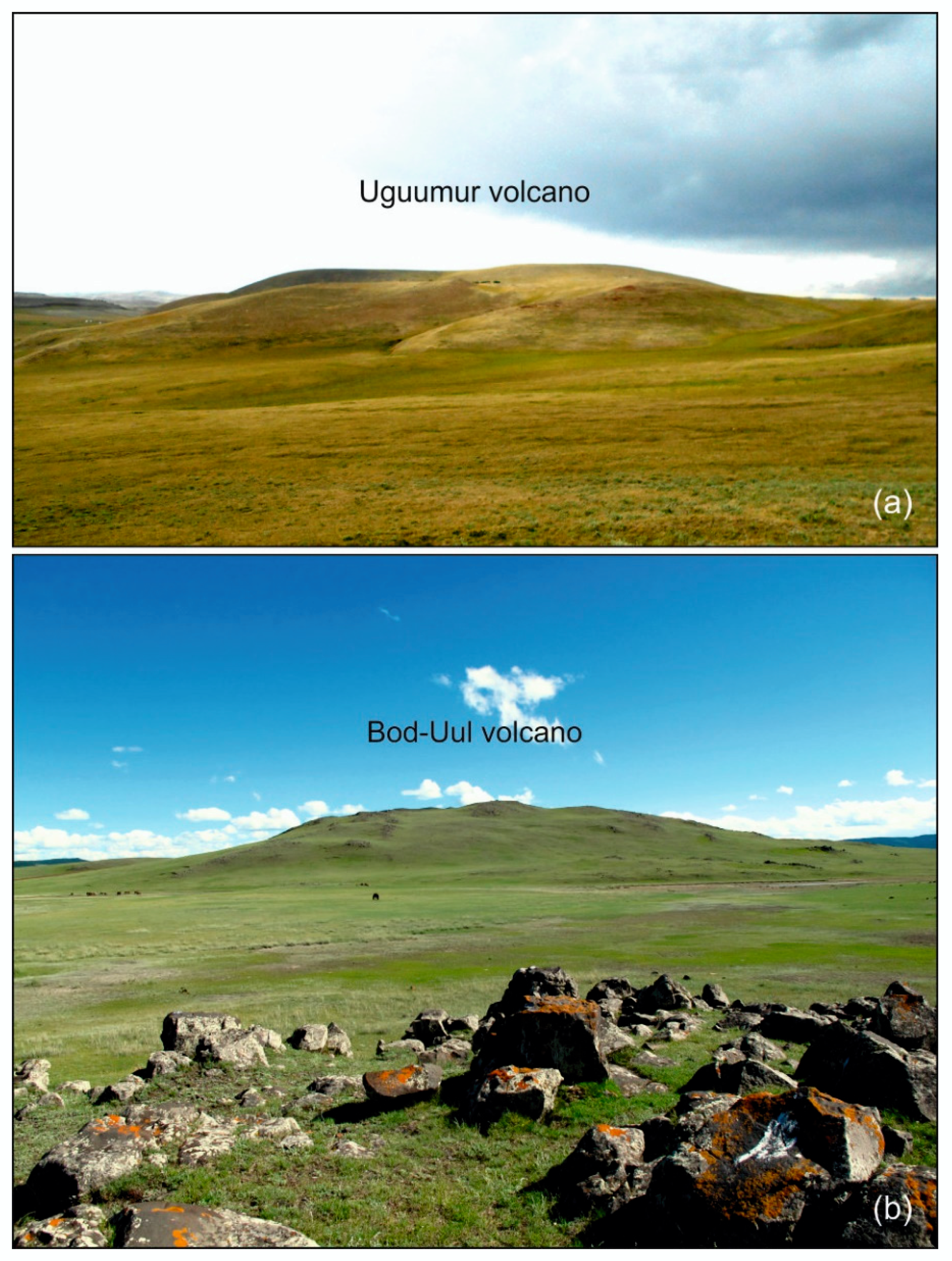
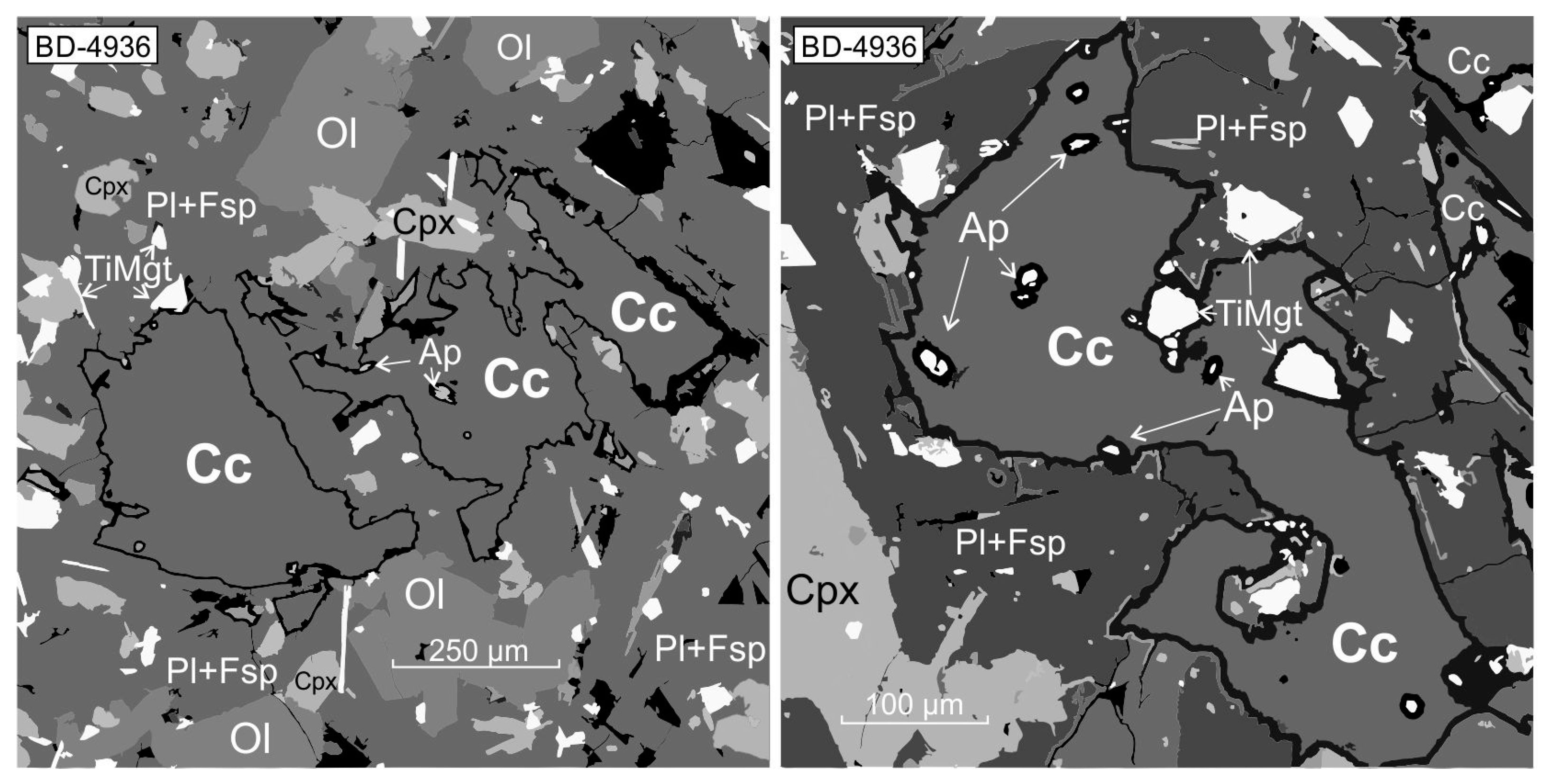


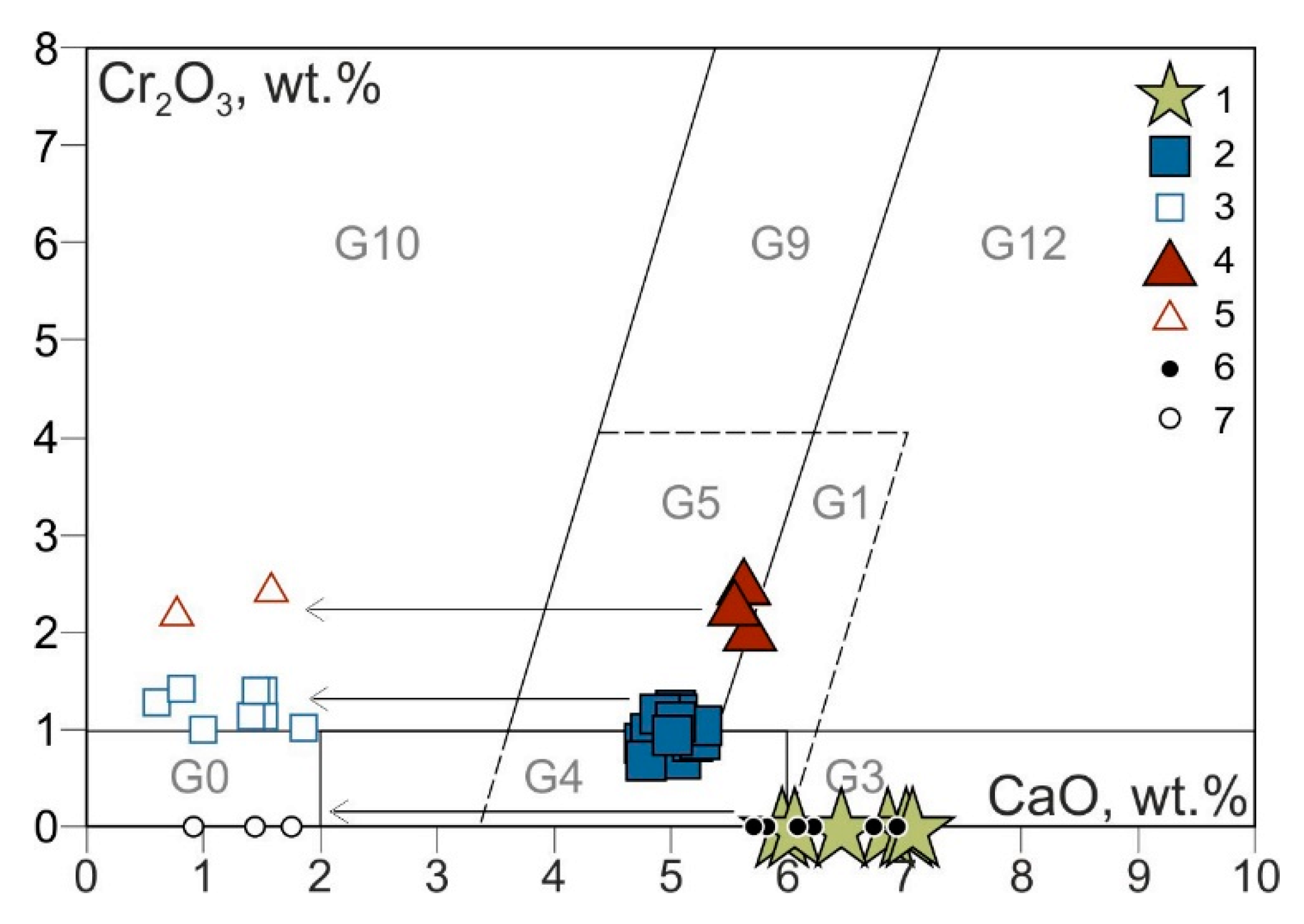
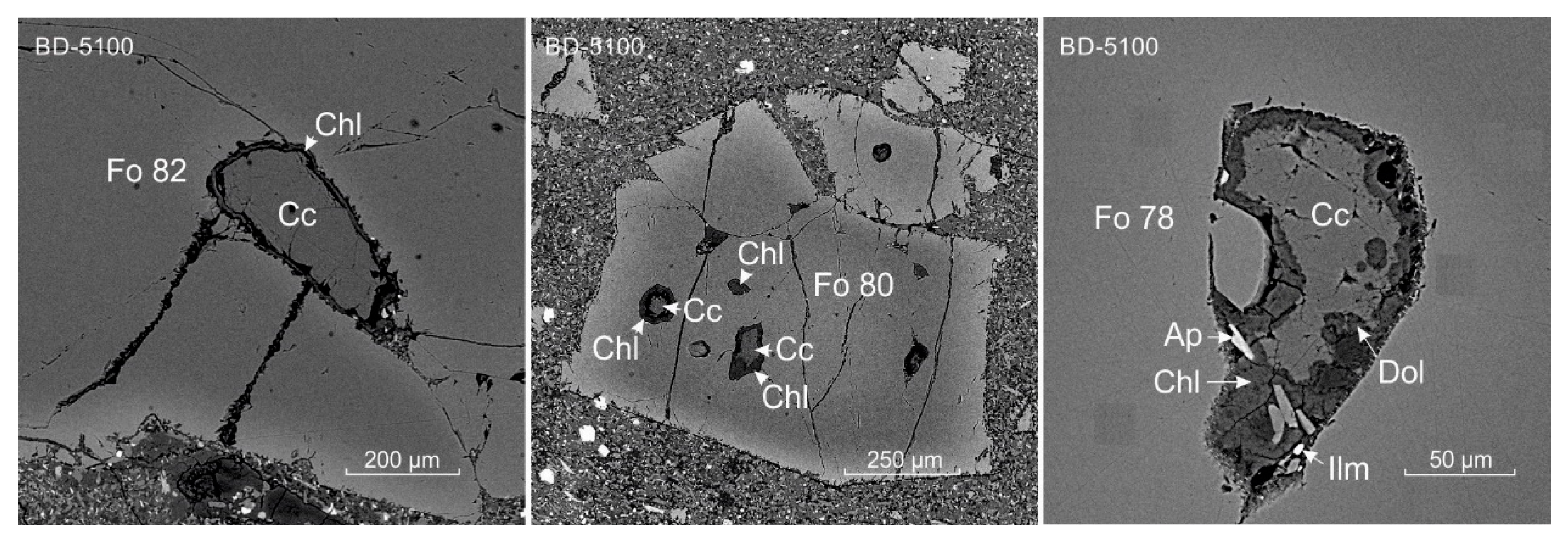
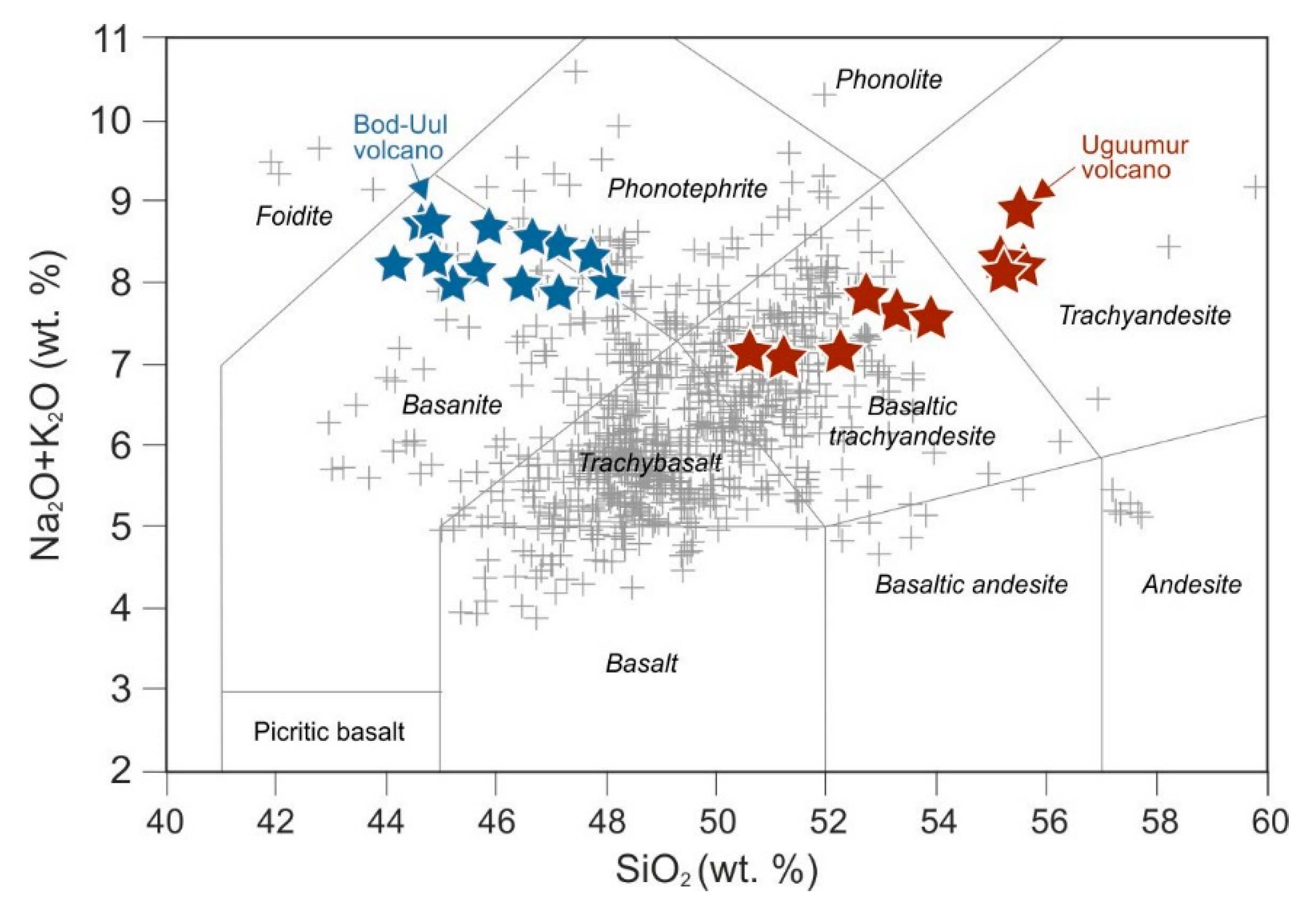
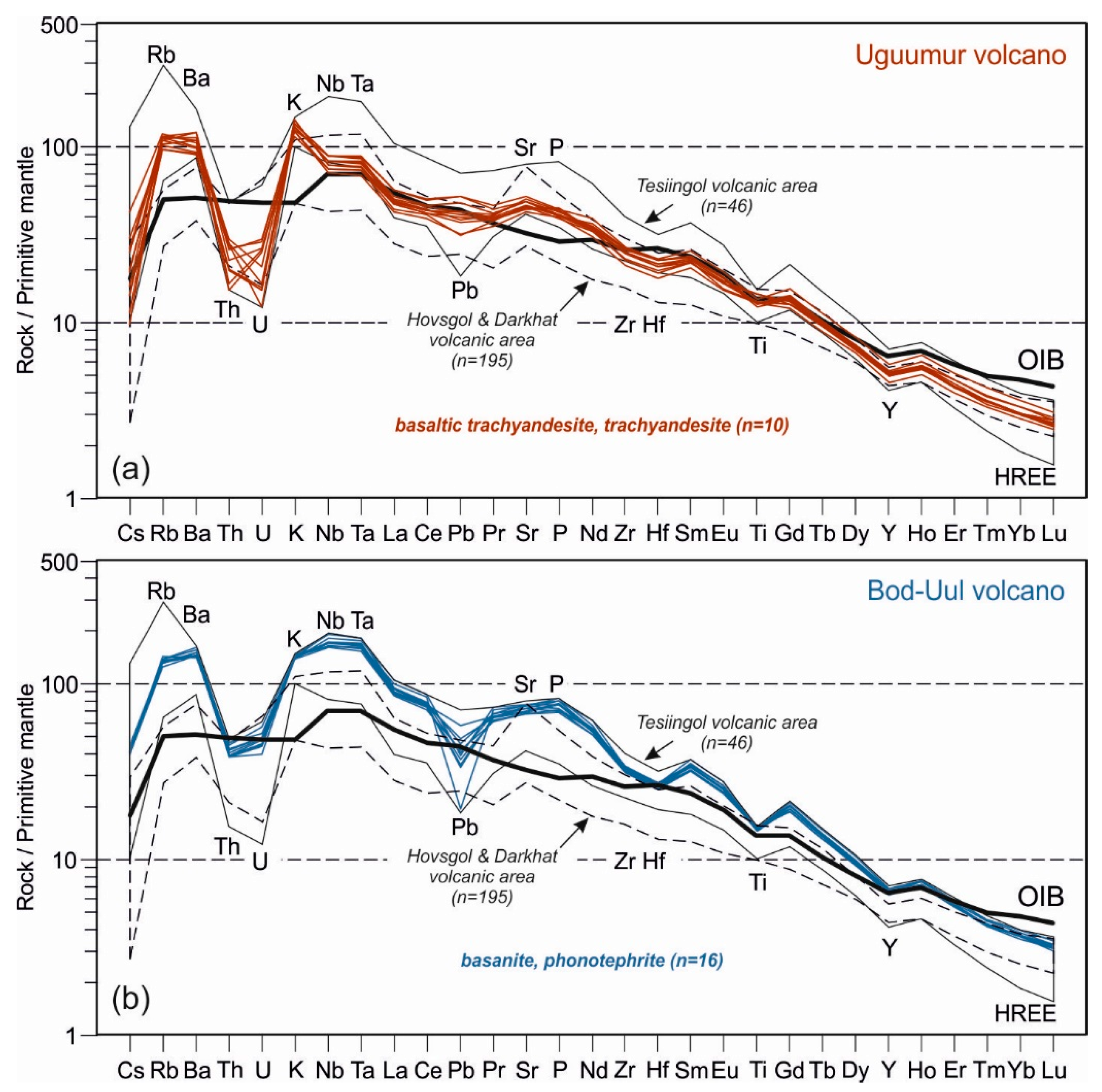
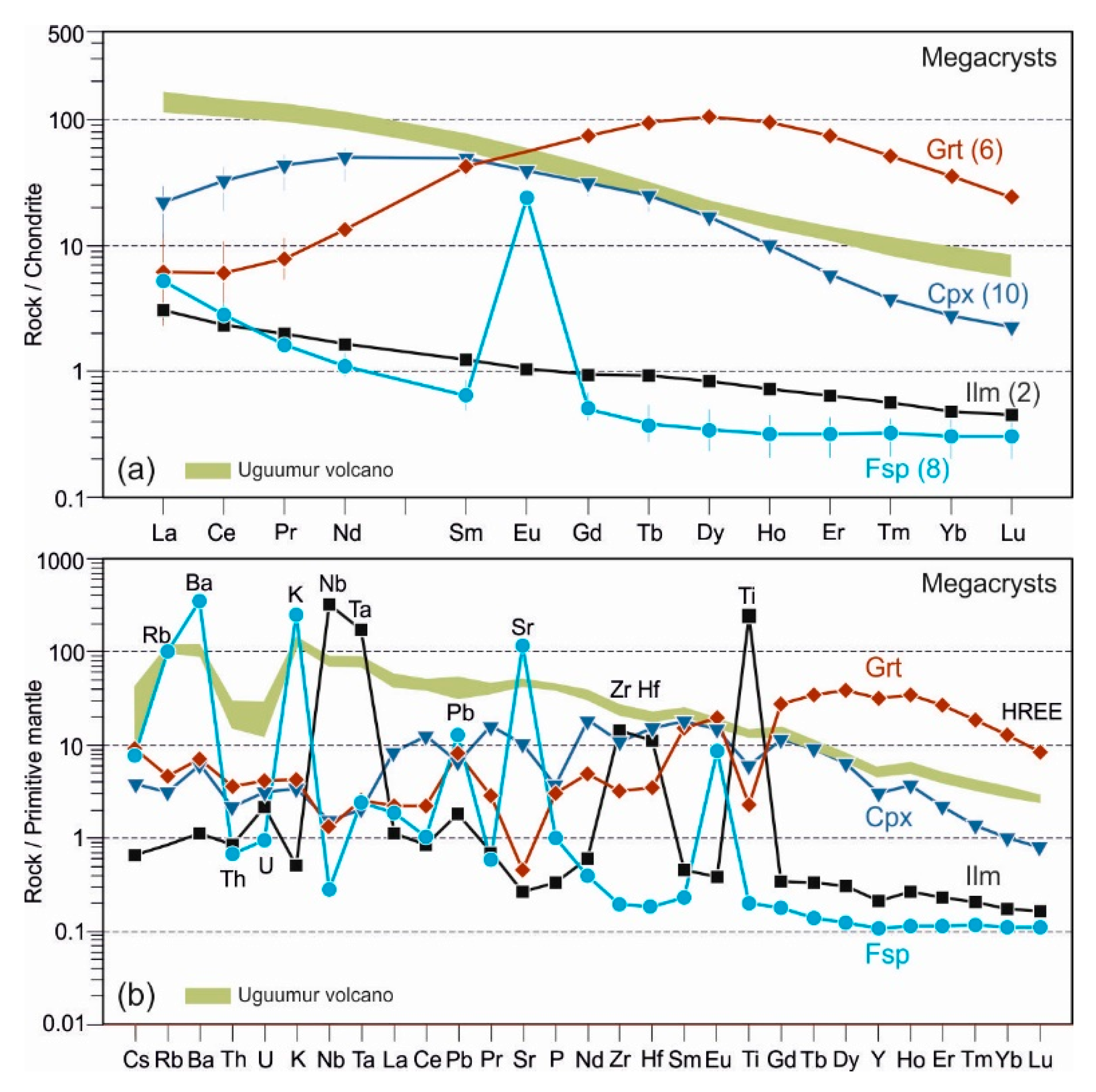

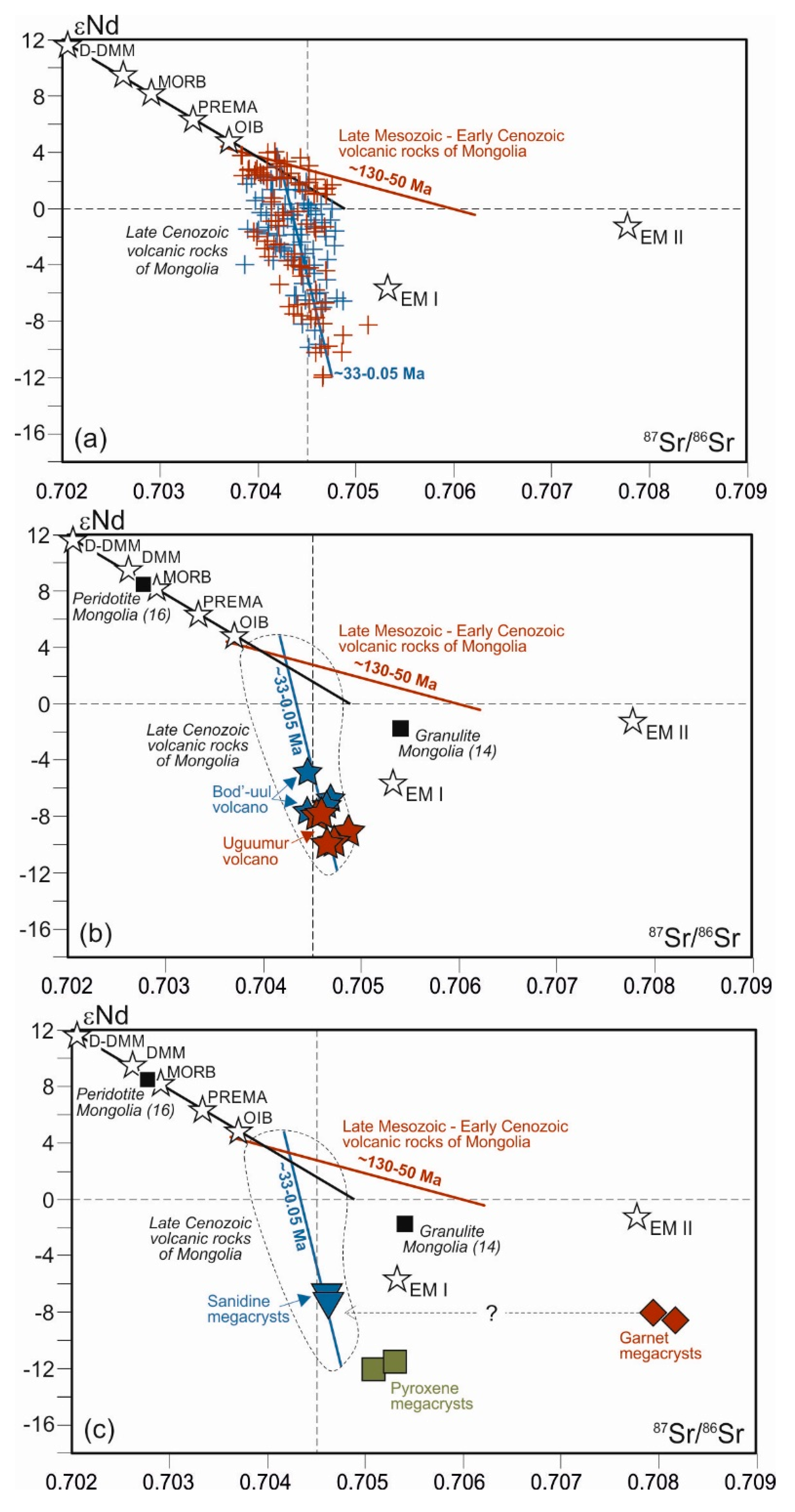
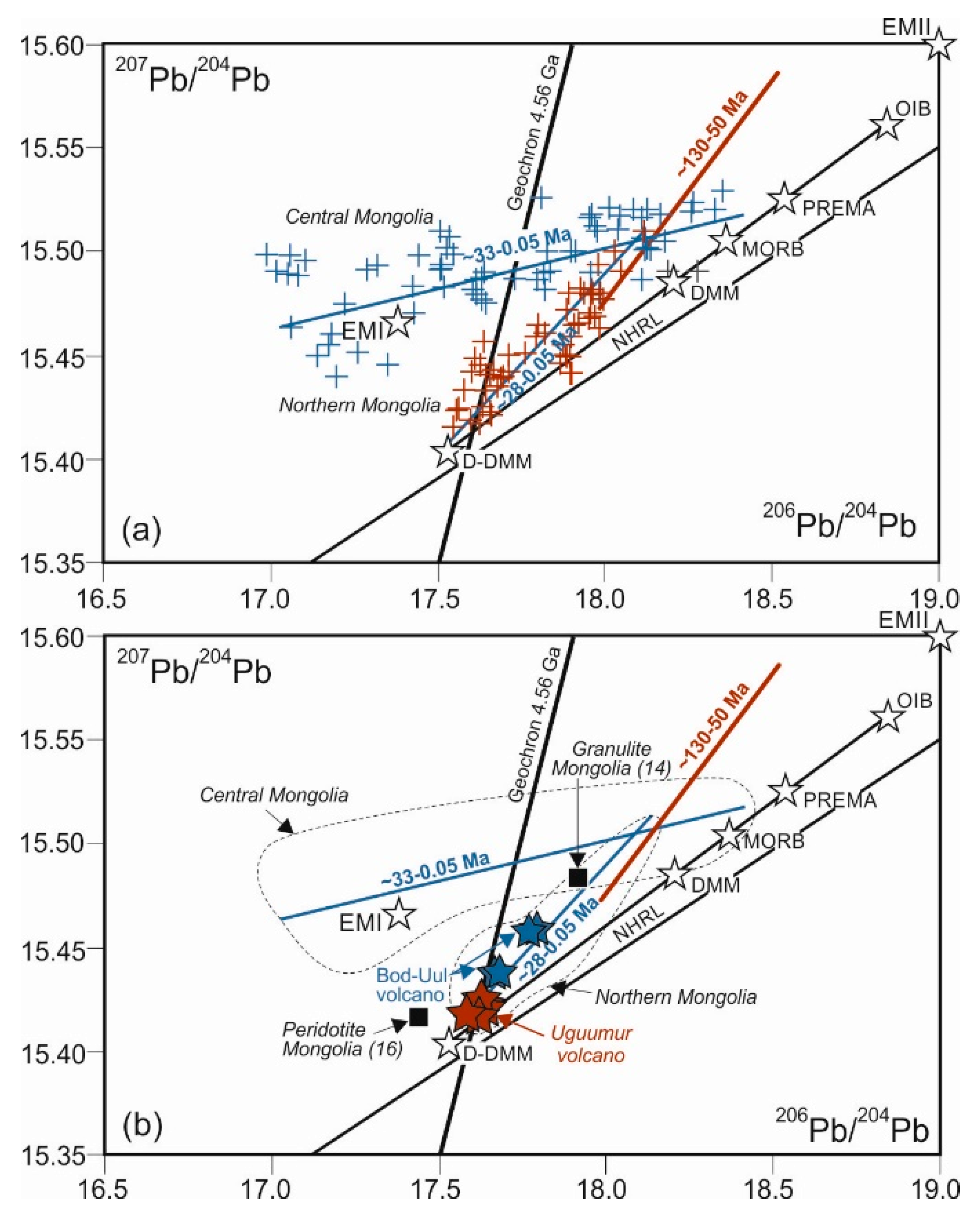

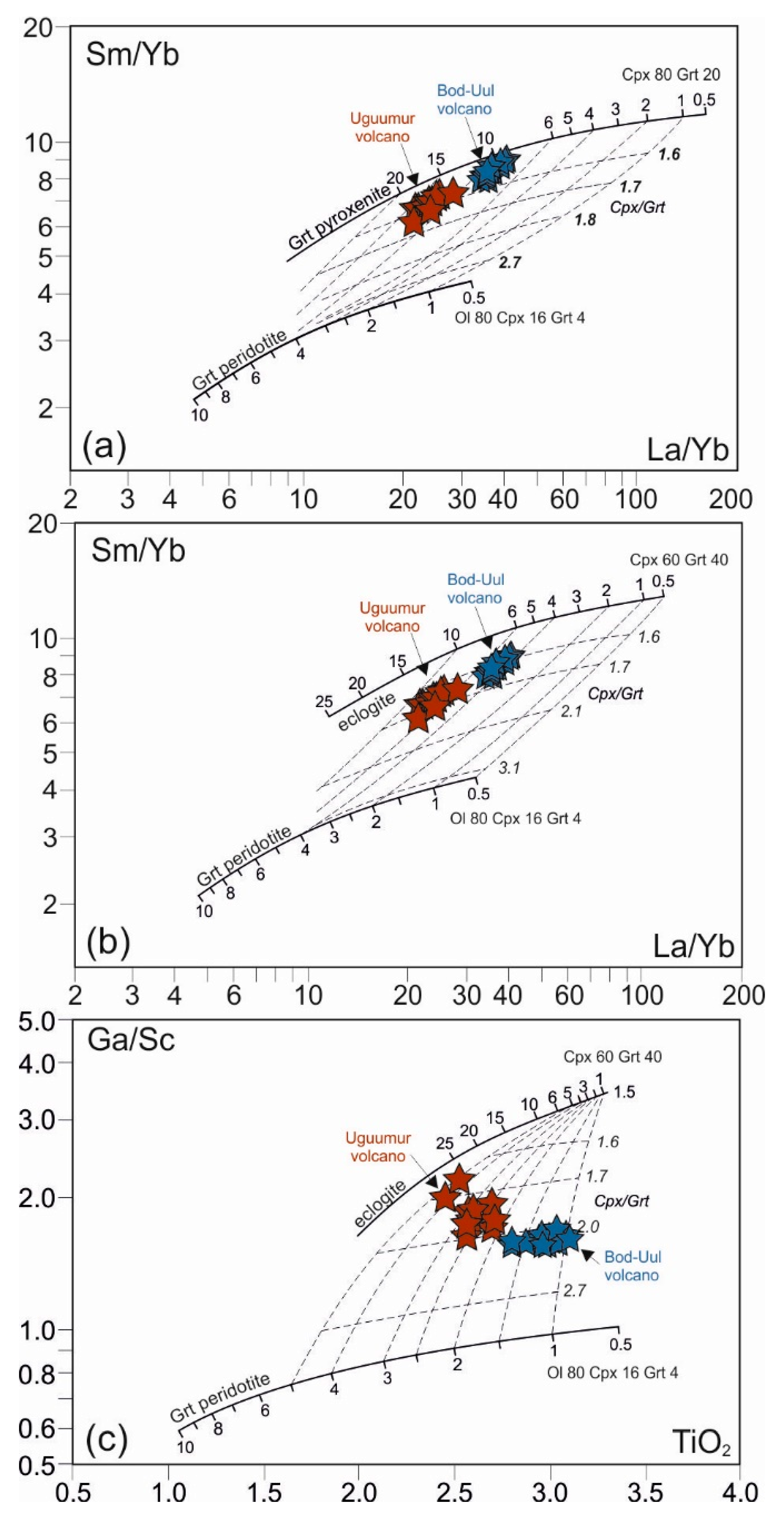

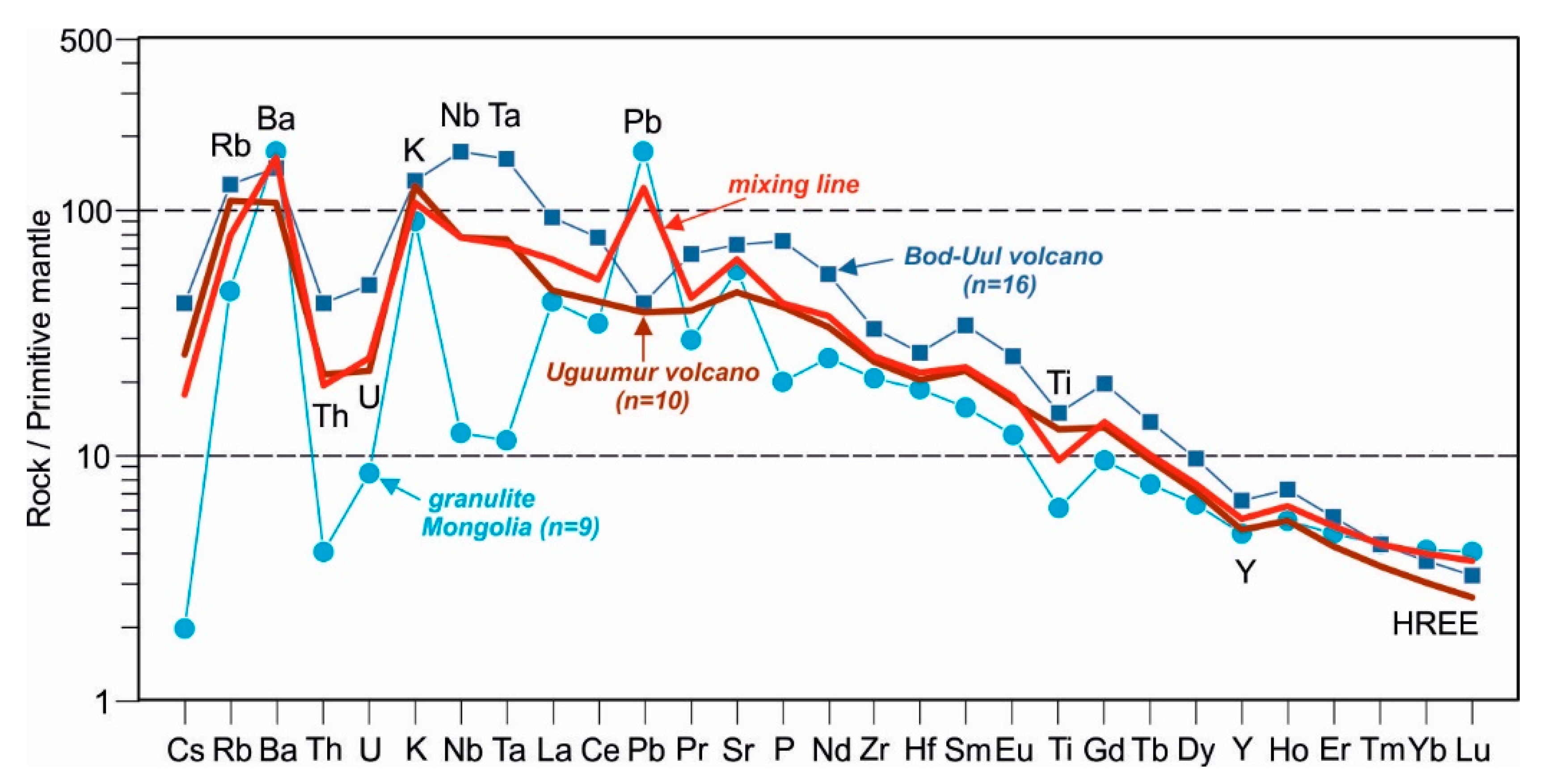

| Mineral | Ol | Cpx | Pl | Pl* | Kfs | Sp | TiMgt | Ilm | Ap | Cc | TiMgt* | Ap* | Dol | GM |
|---|---|---|---|---|---|---|---|---|---|---|---|---|---|---|
| Number of Analysis | 5 | 5 | 4 | 7 | 3 | 4 | 7 | 6 | 9 | 9 | 4 | 6 | 14 | 5 |
| Phases | Phcr | Phcr | Mcr | Mcr | Mcr | Inc* | Mcr | Mcr | Mcr* | Int* | Int* | Int* | Int | SEM |
| SiO2 | 38.23 | 51.15 | 55.75 | 60.62 | 64.72 | 56.79 | ||||||||
| TiO2 | 1.57 | 7.02 | 24.76 | 52.77 | 32.93 | 1.52 | ||||||||
| Al2O3 | 2.18 | 26.09 | 23.33 | 19.82 | 9.45 | 1.57 | 1.17 | 2.64 | 17.62 | |||||
| Cr2O3 | 0.08 | 22.41 | 3.19 | |||||||||||
| Fe2O3 | 1.43 | 0.24 | 0.19 | 0.67 | 21.05 | 15.53 | 3.39 | 2.50 | ||||||
| FeO | 23.29 | 7.45 | 0.49 | 0.38 | 0.00 | 33.46 | 50.77 | 40.68 | 0.70 | 58.57 | 0.59 | 0.26 | 3.55 | |
| MnO | 0.17 | 0.16 | 0.44 | 0.66 | 0.61 | 0.59 | ||||||||
| MgO | 38.46 | 14.85 | 3.23 | 1.81 | 3.53 | 0.31 | 0.56 | 18.30 | 0.93 | |||||
| CaO | 0.17 | 21.29 | 9.26 | 5.48 | 1.42 | 53.95 | 54.45 | 54.38 | 33.11 | 4.41 | ||||
| Na2O | 0.26 | 5.72 | 7.53 | 5.91 | 5.17 | |||||||||
| K2O | 0.52 | 0.94 | 7.22 | 5.06 | ||||||||||
| P2O5 | 38.59 | 39.76 | 0.93 | |||||||||||
| CO2 | 45.02 | 46.96 | ||||||||||||
| Total | 100.32 | 100.27 | 98.06 | 99.76 | 96.79 | 98.06 | 101.02 | 93.24 | 100.56 | 97.81 | 94.73 | 99.21 | 95.97 | |
| End-members | 74.5 Fo | Wo 43.6 | An 51.2 | An 67.4 | An 6.9 | Usp 19.1 | Usp 64.6 | Ilm 87.7 | Cc 99.2 | Usp 92.8 | Cc 55.9 | |||
| 25.3 Fa | En 42.4 | Ab 45.8 | Ab 27.1 | Ab 51.6 | Sp 17.5 | Sp 9.4 | Gkl 11.1 | Mgs 0.8 | Sp 3.1 | Mgs 43.0 | ||||
| 0.2 Tf | Fs 14.0 | Or 3.0 | Or 5.5 | Or 41.5 | Mgt 28.5 | Mgt 20.4 | Prf 1.2 | Sdr 0.0 | Mgt 1.4 | Sdr 1.1 | ||||
| Chr 32.1 | Chr 4.4 | Chr 0.0 |
| Rock | Megacrysts | Peridotitic Xenoliths and Inclusions | ||||||||||||
|---|---|---|---|---|---|---|---|---|---|---|---|---|---|---|
| Mineral | Cpx | Kfs | Grt | Ilm | Ol | Opx | Cpx | Grt | Grt* | Grt** | Sp | Sp* | Sp** | Cc* |
| Number of Analysis | 10 | 8 | 6 | 2 | 7 | 8 | 21 | 19 | 4 | 2 | 6 | 3 | 3 | 4 |
| SiO2 | 48.98 | 65.36 | 39.33 | 40.96 | 55.51 | 52.15 | 42.31 | 42.64 | 42.06 | |||||
| TiO2 | 1.31 | 0.04* | 0.46 | 49.53 | 0.55 | 0.02 | 0.00 | 0.24 | 0.23 | 0.23 | ||||
| Al2O3 | 7.77 | 19.41 | 19.03 | 0.58 | 3.27 | 5.64 | 22.80 | 20.79 | 22.00 | 56.13 | 48.43 | 43.87 | ||
| Cr2O3 | <0.001* | <0.001* | 0.27 | 0.80 | 0.95 | 1.23 | 2.09 | 9.68 | 16.71 | 22.98 | ||||
| Fe2O3 | 0.98 | 0.00 | 5.77 | 0.15 | 1.65 | 1.51 | 6.23 | 0.83 | 2.23 | 3.85 | 3.52 | |||
| FeO | 15.20 | 0.24* | 27.50 | 41.82 | 10.45 | 7.39 | 1.39 | 7.00 | 2.89 | 6.38 | 9.47 | 9.92 | 13.13 | 3.41 |
| MnO | 0.14 | 0.51 | 0.17 | 0.17 | 0.03 | 0.44 | 0.43 | 0.18 | 0.15 | 0.17 | 0.11 | |||
| MgO | 6.50 | 3.70 | 1.05 | 48.53 | 32.43 | 15.52 | 20.60 | 25.63 | 20.62 | 19.93 | 18.93 | 17.01 | 0.59 | |
| CaO | 14.65 | 0.69 | 6.34 | 0.16 | 0.60 | 20.89 | 5.02 | 1.56 | 5.62 | 50.18 | ||||
| Na2O | 2.97 | 5.49 | 0.28* | 1.50 | ||||||||||
| K2O | 0.10* | 7.88 | 0.12* | |||||||||||
| NiO | 0.002* | 0.001* | 0.53 | 0.28 | 0.36 | 0.16 | ||||||||
| CO2 | 45.63 | |||||||||||||
| Total | 98.60 | 99.11 | 97.27 | 99.09 | 100.47 | 99.79 | 100.12 | 100.66 | 101.39 | 100.00 | 98.02 | 98.57 | 101.07 | 99.92 |
| End-members | Aeg 3.4 | An 3.4 | Pyr 14.8 | Ilm 95.8 | Fo 89.2 | Wo 1.2 | Wo 46.7 | Pyr 72.6 | Pyr 89.8 | Pyr 72.8 | Usp 0.0 | Usp 0.5 | Usp 0.5 | Cc 93.4 |
| Jd 23.4 | Ab 49.7 | Alm 61.9 | Gkl 3.8 | Fa 10.8 | En 87.2 | En 48.2 | Alm 13.8 | Alm 5.4 | Alm 12.6 | Sp 78.3 | Sp 76.8 | Sp 69.6 | Mgs 1.5 | |
| Di 73.2 | Or 46.9 | Grs 18.3 | Prf 0.4 | Tf 0.0 | Fs 11.6 | Fs 5.1 | Grs 11.9 | Grs 3.2 | Grs 13.0 | Mgt 2.8 | Mgt 3.9 | Mgt 3.6 | Sdr 5.1 | |
| Chr 10.1 | Chr 18.0 | Chr 24.9 | ||||||||||||
| Rock | Grt-Pyroxenite | Breccia | |||||||||
|---|---|---|---|---|---|---|---|---|---|---|---|
| Mineral | Cpx | Opx | Grt | Grt* | Ilm | Sp | Amph | Dol | Ilm* | Ap* | Cc* |
| Number of Analysis | 5 | 1 | 6 | 2 | 2 | 4 | 3 | 4 | 18 | 10 | 23 |
| SiO2 | 50.35 | 53.27 | 40.78 | 44.84 | 43.09 | ||||||
| TiO2 | 0.89 | 52.99 | 0.58 | 1.91 | 51.16 | ||||||
| Al2O3 | 6.03 | 2.74 | 21.25 | 13.57 | 0.27 | 52.56 | 12.66 | 0.15 | |||
| Cr2O3 | 0.29 | 0.22 | 0.00 | ||||||||
| Fe2O3 | 1.65 | 0.09 | 1.17 | 4.49 | 3.37 | 10.46 | 4.14 | 5.86 | |||
| FeO | 3.59 | 12.75 | 13.86 | 15.84 | 33.34 | 21.14 | 2.76 | 39.14 | 0.91 | 0.77 | |
| MnO | 0.00 | 0.00 | 0.26 | 0.88 | 0.93 | 0.38 | 0.21 | 0.18 | |||
| MgO | 13.59 | 28.31 | 14.80 | 20.03 | 7.50 | 11.98 | 16.90 | 20.93 | 3.73 | 0.33 | |
| CaO | 21.52 | 0.38 | 6.16 | 0.92 | 11.69 | 30.69 | 51.86 | 51.84 | |||
| Na2O | 1.21 | 2.46 | |||||||||
| K2O | 1.31 | ||||||||||
| P2O5 | 39.16 | ||||||||||
| F | 1.83 | 3.80 | |||||||||
| CO2 | 46.94 | 41.71 | |||||||||
| Total | 98.83 | 97.83 | 98.28 | 100.57 | 98.40 | 97.32 | 98.75 | 98.55 | 100.25 | 95.73 | 94.88 |
| End-members | Wo 48.5 | Wo 0.76 | Pyr 54.5 | Pyr 66.6 | Ilm 76.9 | Usp 1.2 | Cc 51.3 | Ilm 86.6 | Cc 95.0 | ||
| En 42.6 | En 79.12 | Alm 28.7 | Alm 29.6 | Gkl 21.6 | Sp 50.4 | Mgs 48.7 | Gkl 13.0 | Mgs 1.6 | |||
| Fs 8.9 | Fs 20.12 | Grs 15.7 | Grs 1.8 | Prf 1.5 | Mgt 11.1 | Sdr 0.0 | Prf 0.4 | Sdr 1.8 | |||
| Sps 0.5 | Sps 1.7 | Hrc 36.1 | Rdn 1.5 | ||||||||
| Mineral | Ol | Ol* | Kfs* | Lc* | Ne* | Sp* | Cpx** | TiMgt** | Ilm** | Ap* | Cc | Cc | Dol | Chl | GM |
|---|---|---|---|---|---|---|---|---|---|---|---|---|---|---|---|
| Number of Analysis | 6 | 6 | 3 | 2 | 5 | 9 | 14 | 3 | 6 | 2 | 5 | 4 | 4 | 6 | 2 |
| Phases | Phcr | Phcr | Phcr | Phcr | Phcr | Inc* | Mcr | Mcr | Mcr | Mcr* | Inc* | Inc* | Inc* | Inc* | SEM |
| SiO2 | 38.79 | 38.96 | 65.70 | 54.86 | 47.02 | 51.11 | 3.05 | 35.2 | 48.28 | ||||||
| TiO2 | 9.11 | 1.74 | 20.03 | 56.15 | 1.19 | 13.71 | 3.27 | ||||||||
| Al2O3 | 19.05 | 21.78 | 29.66 | 4.74 | 2.03 | 0.67 | 0.38 | 15.24 | |||||||
| Cr2O3 | 20.29 | 0.29 | 0.44 | ||||||||||||
| Fe2O3 | 0.84 | 0.53 | 0.48 | 0.57 | 26.37 | 3.32 | 30.22 | 1.67 | |||||||
| FeO | 16.77 | 16.78 | 0.87 | 38.06 | 4.56 | 44.63 | 35.41 | 0.41 | 0.94 | 1.35 | 15.3 | 6.32 | |||
| MnO | 0.34 | 0.41 | 0.55 | 0.32 | 0.63 | 0.65 | 0.42 | 1.59 | 0.38 | 0.33 | |||||
| MgO | 42.52 | 42.63 | 1.61 | 13.80 | 2.62 | 5.52 | 2.19 | 5.71 | 20.47 | 18.31 | 4.33 | ||||
| CaO | 0.24 | 0.24 | 0.71 | 22.18 | 53.97 | 51.49 | 44.22 | 28.04 | 0.65 | 7.88 | |||||
| Na2O | 5.66 | 16.60 | 1.09 | 7.24 | |||||||||||
| K2O | 9.07 | 22.79 | 3.62 | 0.72 | 3.67 | ||||||||||
| P2O5 | 41.44 | 0.72 | 0.54 | 1.71 | |||||||||||
| NiO | 0.48 | 0.45 | |||||||||||||
| F | 3.97 | ||||||||||||||
| CO2 | 44.19 | 44.64 | 47.04 | ||||||||||||
| Total | 99.98 | 100.01 | 100.66 | 99.99 | 97.76 | 100.73 | 100.43 | 98.80 | 100.22 | 99.37 | 99.42 | 97.64 | 101.52 | 84.22 | 97.92 |
| End-members | Fo 81.2 | Fo 81.4 | An 3.3 | Ks 77.2 | Ks 11.5 | Usp 24.7 | Wo 46.9 | Usp 56.4 | Ilm 78.0 | Cc 93.9 | Cc 83.6 | Cc 48.7 | |||
| Fa 18.8 | Fa 18.5 | Ab 47.3 | Ne 0.0 | Ne 80.1 | Sp 8.6 | En 40.6 | Sp 14.6 | Gkl 20.6 | Mgs 5.5 | Mgs 15.0 | Mgs 49.5 | ||||
| Tf 0.1 | Tf 0.1 | Or 49.4 | Fs 22.8 | Fs 8.4 | Mgt 36.3 | Fs 12.5 | Mgt 42.1 | Prf 1.4 | Sdr 0.6 | Sdr 1.4 | Sdr 1.8 | ||||
| Chr 28.9 | Chr 0.0 |
| Volcano | Uguumur | Bod-Uul | Volcano | Uguumur | Bod-Uul | ||||
|---|---|---|---|---|---|---|---|---|---|
| Rock | BTA | TA | BS | PT | Rocks | BTA | TA | BS | PT |
| Number of Analysis | 6 | 3 | 6 | 7 | 6 | 3 | 6 | 7 | |
| SiO2, wt% | 52.31 | 55.31 | 44.79 | 46.99 | Y | 21 | 23 | 28 | 27 |
| TiO2 | 2.56 | 2.65 | 2.96 | 3.02 | Zr | 250 | 271 | 347 | 330 |
| Al2O3 | 14.36 | 15.46 | 12.59 | 13.18 | Nb | 51 | 56 | 122 | 108 |
| Fe2O3 | 4.69 | 2.97 | 4.43 | 4.06 | Mo | 1.4 | 1.4 | 3.1 | 2.5 |
| FeO | 5.51 | 4.49 | 6.46 | 6.61 | Sn | 3.3 | 3.7 | 3.4 | 3.2 |
| MnO | 0.12 | 0.08 | 0.15 | 0.14 | Cs | 0.54 | 0.28 | 0.86 | 0.84 |
| MgO | 5.01 | 3.43 | 8.93 | 7.53 | Ba | 704 | 656 | 987 | 955 |
| CaO | 6.07 | 5.76 | 7.71 | 7.22 | La | 30.6 | 34.6 | 62.3 | 56.0 |
| Na2O | 3.84 | 4.34 | 4.29 | 4.23 | Ce | 71.4 | 79.0 | 134.4 | 121.4 |
| K2O | 3.58 | 3.97 | 3.98 | 4.05 | Pr | 9.86 | 10.79 | 17.26 | 15.75 |
| P2O5 | 0.83 | 0.89 | 1.59 | 1.48 | Nd | 41.8 | 45.0 | 71.0 | 64.2 |
| LOI | 1.28 | 0.83 | 1.39 | 0.90 | Sm | 8.97 | 9.57 | 14.04 | 13.04 |
| Total | 100.16 | 100.18 | 99.27 | 99.42 | Eu | 2.55 | 2.75 | 4.01 | 3.68 |
| Mg# | 54.3 | 52.5 | 66.3 | 62.8 | Gd | 7.05 | 7.56 | 10.90 | 10.21 |
| HyN*, NeN | 4.1* | 8.9* | 16.3 | 11.8 | Tb | 0.95 | 1.01 | 1.38 | 1.29 |
| Li, ppm | 12 | 10 | 12 | 11 | Dy | 4.78 | 5.04 | 6.60 | 6.30 |
| Be | 2.27 | 1.96 | 3.27 | 2.99 | Ho | 0.81 | 0.86 | 1.08 | 1.04 |
| Sc | 14 | 13 | 15 | 14 | Er | 1.87 | 1.99 | 2.44 | 2.33 |
| V | 148 | 125 | 156 | 150 | Tm | 0.24 | 0.25 | 0.29 | 0.28 |
| Cr | 108 | 85 | 220 | 174 | Yb | 1.32 | 1.39 | 1.64 | 1.61 |
| Co | 34 | 27 | 44 | 38 | Lu | 0.18 | 0.19 | 0.22 | 0.22 |
| Ni | 61 | 48 | 205 | 159 | Hf | 5.75 | 6.21 | 7.52 | 7.23 |
| Cu | 30 | 31 | 57 | 51 | Ta | 2.83 | 3.10 | 6.47 | 5.86 |
| Zn | 135 | 143 | 143 | 133 | W | 0.56 | 0.54 | 1.77 | 1.27 |
| Ga | 24.8 | 24.8 | 23.4 | 23.9 | Tl | 0.08 | 0.11 | 0.06 | 0.07 |
| Ge | 1.36 | 1.34 | 1.25 | 1.38 | Pb | 2.74 | 3.36 | 2.73 | 2.60 |
| Rb | 65 | 65 | 81 | 75 | Th | 1.67 | 2.04 | 3.44 | 3.09 |
| Sr | 941 | 1006 | 1489 | 1340 | U | 0.45 | 0.36 | 1.05 | 0.91 |
| Megacrysts | Kfs | Cpx | Grt | Ilm | Megacrysts | Kfs | Cpx | Grt | Ilm |
|---|---|---|---|---|---|---|---|---|---|
| Number Analysis | 8 | 11 | 6 | 2 | 8 | 3 | 6 | 2 | |
| SiO2, wt% | 65.35 | 48.98 | 37.41 | Y | 0.47 | 13.09 | 132.96 | 0.90 | |
| TiO2 | 0.08 | 1.31 | 0.47 | 49.53 | Zr | 2.07 | 109 | 34.09 | 152 |
| Al2O3 | 19.41 | 7.77 | 20.49 | 0.58 | Nb | 0.19 | 0.93 | 0.86 | 211 |
| Fe2O3 | 0.25 | 0.98 | 2.80 | 5.77 | Mo | 0.02 | 0.11 | 0.12 | 6.50 |
| FeO | 0.00 | 15.20 | 28.09 | 41.82 | Sn | 0.25 | 2.21 | 0.35 | 3.64 |
| MnO | 0.002 | 0.14 | 0.61 | 0.17 | Cs | 0.16 | 0.07 | 0.19 | 0.01 |
| MgO | 0.03 | 6.50 | 3.58 | 1.05 | Ba | 2299 | 38.9 | 46.1 | 7.39 |
| CaO | 0.68 | 14.65 | 6.82 | 0.16 | La | 1.23 | 5.13 | 1.44 | 0.77 |
| Na2O | 5.49 | 2.97 | 0.22 | 0.03 | Ce | 1.72 | 19.92 | 3.67 | 1.43 |
| K2O | 7.88 | 0.14 | 0.15 | 0.01 | Pr | 0.15 | 3.98 | 0.73 | 0.18 |
| P2O5 | 0.02 | 0.07 | 0.06 | 0.01 | Nd | 0.49 | 22.60 | 6.10 | 0.75 |
| Total | 99.19 | 98.71 | 100.70 | 99.42 | Sm | 0.09 | 7.20 | 6.12 | 0.19 |
| End-members | Or 46.9 | Di 73.19 | Alm 64.1 | Ilm 95.8 | Eu | 1.34 | 2.19 | 2.98 | 0.06 |
| Ab 49.7 | Jd 23.39 | Grs 18.1 | Gkl 3.8 | Gd | 0.10 | 6.17 | 14.93 | 0.24 | |
| An 3.4 | Ae 3.42 | Prp 14.6 | Prf 0.4 | Tb | 0.01 | 0.89 | 3.39 | 0.03 | |
| Li, ppm | 5.97 | 13.6 | 1.07 | 1.43 | Dy | 0.08 | 4.16 | 25.88 | 0.21 |
| Be | 0.24 | 0.85 | 0.14 | 0.03 | Ho | 0.02 | 0.55 | 5.13 | 0.04 |
| Sc | 0.29 | 16.2 | 14.2 | 3.89 | Er | 0.05 | 0.94 | 11.70 | 0.10 |
| V | 1.52 | 124 | 33.8 | 118 | Tm | 0.01 | 0.09 | 1.24 | 0.01 |
| Cr | 0.20 | 0.75 | 0.47 | 2.35 | Yb | 0.05 | 0.45 | 5.63 | 0.11 |
| Co | 0.33 | 48.5 | 42.5 | 103 | Lu | 0.01 | 0.05 | 0.57 | 0.01 |
| Ni | 0.30 | 12.9 | 4.16 | 25.2 | Hf | 0.05 | 4.16 | 1.00 | 3.18 |
| Cu | 1.93 | 7.39 | 5.61 | 100 | Ta | 0.09 | 0.07 | 0.10 | 6.45 |
| Zn | 3.28 | 219 | 145 | 698 | W | 0.05 | 0.05 | 0.11 | 0.29 |
| Ga | 21.0 | 26.1 | 16.3 | 10.6 | Tl | 0.07 | 0.03 | 0.04 | 0.01 |
| Ge | 0.55 | 1.49 | 2.98 | 0.64 | Pb | 0.91 | 0.45 | 0.58 | 0.13 |
| Rb | 60.4 | 1.8 | 2.8 | 0.5 | Th | 0.05 | 0.16 | 0.28 | 0.07 |
| Sr | 2301 | 197 | 9.17 | 5.24 | U | 0.02 | 0.06 | 0.08 | 0.04 |
| Sample ID | Rb | Sr | 87Sr/86Sr | 2σ | 87Sr/86Sr(i) | Sm | Nd | 143Nd/144Nd | 2σ | 143Nd/144Nd(i) | εNd(i) |
|---|---|---|---|---|---|---|---|---|---|---|---|
| Ugumuur volcano | |||||||||||
| BD-4935 | 65 | 922 | 0.70475 | 2 | 0.70473 | 8.7 | 40.0 | 0.512132 | 5 | 0.512125 | −9.80 |
| BD-4936 | 64 | 919 | 0.70468 | 4 | 0.70466 | 8.4 | 39.0 | 0.512126 | 5 | 0.512119 | −9.92 |
| BD-4939 | 65 | 962 | 0.70462 | 2 | 0.70460 | 9.2 | 42.9 | 0.512235 | 6 | 0.512228 | −7.79 |
| BD-4938 | 70 | 1043 | 0.70457 | 3 | 0.70455 | 10.4 | 49.2 | 0.512229 | 6 | 0.512222 | −7.91 |
| BD-5090 | 132 | 1016 | 0.70492 | 2 | 0.70488 | 9.3 | 44.1 | 0.512172 | 9 | 0.512165 | −9.02 |
| Bod-Uul volcano | |||||||||||
| BD-5097 | 79 | 1526 | 0.70447 | 2 | 0.70445 | 14.1 | 71.3 | 0.512385 | 6 | 0.512379 | −4.86 |
| BD-5098 | 75 | 1340 | 0.70467 | 1 | 0.70465 | 13.0 | 64.2 | 0.512266 | 14 | 0.512260 | −7.18 |
| BD-5099 | 85 | 1430 | 0.70471 | 1 | 0.70469 | 13.9 | 69.3 | 0.512289 | 9 | 0.512283 | −6.73 |
| BD-5100 | 82 | 1516 | 0.70447 | 2 | 0.70445 | 14.9 | 76.9 | 0.512241 | 12 | 0.512235 | −7.66 |
| Sample ID | U | Th | Pb | 206Pb/204Pb | 2σ | 207Pb/204Pb | 2σ | 208Pb/204Pb | 2σ | 206Pb/204Pb(i) | 207Pb/204Pb(i) | 208Pb/204Pb(i) |
|---|---|---|---|---|---|---|---|---|---|---|---|---|
| Uguumur Volcano | ||||||||||||
| BD-4935 | 0.55 | 1.72 | 2.33 | 17.6583 | 18 | 15.4231 | 16 | 37.6081 | 40 | 17.6401 | 15.4223 | 37.5894 |
| BD-4936 | 0.55 | 1.63 | 2.31 | 17.6616 | 15 | 15.4213 | 13 | 37.5967 | 33 | 17.6433 | 15.4205 | 37.5788 |
| BD-4939 | 0.28 | 1.95 | 2.98 | 17.6279 | 15 | 15.4172 | 15 | 37.6046 | 36 | 17.6207 | 15.4169 | 37.5880 |
| BD-4938 | 0.36 | 2.16 | 3.40 | 17.6360 | 16 | 15.4256 | 15 | 37.6263 | 35 | 17.6279 | 15.4252 | 37.6102 |
| BD-5090 | 0.64 | 2.12 | 2.95 | 17.5997 | 14 | 15.4187 | 14 | 37.6084 | 34 | 17.5830 | 15.4179 | 37.5902 |
| Bod-Uul Volcano | ||||||||||||
| BD-5097 | 1.12 | 3.88 | 3.35 | 17.5997 | 14 | 15.4187 | 14 | 37.6084 | 34 | 17.7959 | 15.4591 | 37.6734 |
| BD-5098 | 0.91 | 3.09 | 2.60 | 17.8217 | 9 | 15.4603 | 9 | 37.7028 | 24 | 17.6654 | 15.4374 | 37.5700 |
| BD-5099 | 1.00 | 3.34 | 2.87 | 17.6925 | 13 | 15.4387 | 12 | 37.6001 | 32 | 17.6720 | 15.4385 | 37.5997 |
| BD-5100 | 1.00 | 3.32 | 2.75 | 17.6989 | 15 | 15.4397 | 13 | 37.6293 | 33 | 17.7679 | 15.4579 | 37.6415 |
| Sample ID | Rb | Sr | 87Sr/86Sr | 2σ | 87Sr/86Sr(i) | Sm | Nd | 143Nd/144Nd | 2σ | 143Nd/144Nd(i) | εNd(i) |
|---|---|---|---|---|---|---|---|---|---|---|---|
| UG-grt-1 | 4.8 | 22.2 | 0.70845 | 1 | 0.70838 | 6.2 | 7.2 | 0.512199 | 9 | 0.512172 | −8.89 |
| UG-grt-2c | 3.5 | 19.2 | 0.70811 | 1 | 0.70805 | 5.5 | 6.6 | 0.512226 | 7 | 0.512199 | −8.35 |
| UG-Fsp-6 | 62.1 | 2567 | 0.70463 | 1 | 0.70461 | 0.11 | 0.57 | 0.512263 | 20 | 0.512257 | −7.24 |
| UG-Fsp-21 | 58.7 | 2109 | 0.70462 | 2 | 0.70461 | 0.20 | 1.00 | 0.512295 | 8 | 0.512289 | −6.61 |
| UG-Cpx-2 | 3.3 | 192 | 0.70509 | 2 | 0.70508 | 8.6 | 27.3 | 0.512019 | 9 | 0.512009 | −12.07 |
| UG-Cpx-8 | 1.7 | 215 | 0.70531 | 1 | 0.70531 | 7.1 | 22.8 | 0.512048 | 7 | 0.512038 | −11.50 |
© 2020 by the authors. Licensee MDPI, Basel, Switzerland. This article is an open access article distributed under the terms and conditions of the Creative Commons Attribution (CC BY) license (http://creativecommons.org/licenses/by/4.0/).
Share and Cite
Perepelov, A.; Kuzmin, M.; Tsypukova, S.; Shcherbakov, Y.; Dril, S.; Didenko, A.; Dalai-Erdene, E.; Puzankov, M.; Zhgilev, A. Late Cenozoic Uguumur and Bod-Uul Volcanic Centers in Northern Mongolia: Mineralogy, Geochemistry, and Magma Sources. Minerals 2020, 10, 612. https://doi.org/10.3390/min10070612
Perepelov A, Kuzmin M, Tsypukova S, Shcherbakov Y, Dril S, Didenko A, Dalai-Erdene E, Puzankov M, Zhgilev A. Late Cenozoic Uguumur and Bod-Uul Volcanic Centers in Northern Mongolia: Mineralogy, Geochemistry, and Magma Sources. Minerals. 2020; 10(7):612. https://doi.org/10.3390/min10070612
Chicago/Turabian StylePerepelov, Alexander, Mikhail Kuzmin, Svetlana Tsypukova, Yuri Shcherbakov, Sergey Dril, Alexey Didenko, Enkhbat Dalai-Erdene, Mikhail Puzankov, and Alexander Zhgilev. 2020. "Late Cenozoic Uguumur and Bod-Uul Volcanic Centers in Northern Mongolia: Mineralogy, Geochemistry, and Magma Sources" Minerals 10, no. 7: 612. https://doi.org/10.3390/min10070612
APA StylePerepelov, A., Kuzmin, M., Tsypukova, S., Shcherbakov, Y., Dril, S., Didenko, A., Dalai-Erdene, E., Puzankov, M., & Zhgilev, A. (2020). Late Cenozoic Uguumur and Bod-Uul Volcanic Centers in Northern Mongolia: Mineralogy, Geochemistry, and Magma Sources. Minerals, 10(7), 612. https://doi.org/10.3390/min10070612






